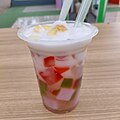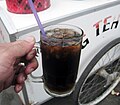| Name | Image | Region | Type | Description |
|---|
| Beras kencur [ id ] |  | Java | Herbal drink | Made from rice, turmeric, and brown sugar. |
| Bir kocok | | Bogor, West Java | Ginger drink | Shaken ginger drink with ice |
| Bir pletok |  | Jakarta | Ginger drink | Shaken ginger drink with ice |
| Dadiah |  | West Sumatra | Yoghurt | Traditional West Sumatran water buffalo milk yoghurt. [4] |
| Es asam jawa or air gula asam |  | Central Java and Yogyakarta | Tamarind drink | A cold drink made from the juice of asam jawa served with palm sugar and ice. |
| Es air mata pengantin | | Riau | Cold drink | A cold drink consists of the three layer colorful grated agar jelly and basil seeds. |
| Es blewah |  | Nationwide | Fruit cocktail | A cold drink made from the fruit of blewah. |
| Es buah |  | Nationwide | Fruit cocktail | A cold drink from fruit, ice, syrup and condensed milk |
| Es campur |  | Nationwide | Sweet dessert | Shaved ice with coconut pieces, various fruits (usually jackfruit), grass jelly, syrup and condensed milk |
| Es cao | | Central Java and East Java | Jelly drink | A cold drink made from black grass jelly with cocopandan syrup. |
| Es cendol |  | Nationwide | Sweet jelly drink | Rice flour jelly with green natural coloring from pandan leaf, mixed with coconut milk, shaved ice and palm/brown sugar |
| Es cincau |  | Nationwide | Jelly drink | Grass jelly and shredded ice with sugar or syrup. |
| Es dawet |  | Banjarnegara, Central Java | Cold dessert | |
| Es doger |  | Bandung, West Java | Cold sweet dessert | |
| Es durian |  | Nationwide | Cold sweet dessert | |
| Es goyobod |  | West Java | Cold sweet dessert | |
| Es gempol |  | Central Java | Cold sweet dessert | Rice flour dough doused with coconut milk soup |
| Es jeruk | | Nationwide | Cold drink | Juice of sweet orange with sugar and ice |
| Es kelacin | | West Sulawesi | Cold drink | Flesh coconut mixed with green grass jelly in an iced coconut milk soup. |
| Es kelapa muda |  | Nationwide | Cold drink | Fresh young coconut, coconut water mixed with or without syrup. Usually served intact whole fruit |
| Es kopi susu gula aren |  | Nationwide | Cold drink | Iced coffee with milk and palm sugar. |
| Es kuwut | | Bali | Cold drink | Consists of coconut, citrus, honeydew, and selasih (basil seeds). |
| Es laksamana mengamuk | | Riau Islands | Cold dessert | Fresh mango with milk. |
| Es lidah buaya | | West Kalimantan | Cold drink | Made from aloe vera, French basil, Javanese black jelly, coconut milk, palm sugar, pandanus leaf, and sugar. |
| Es matoa | | Papua | Cold drink | Made from matoa fruit, kolang-kaling (aren palm fruit), and jelly. |
| Es omu | | Gorontalo | Cold drink | Made from coconut flesh, coconut water, and palm sugar. |
| Es pisang ijo |  | South Sulawesi | Cold dessert | Sweet green battered banana with rice pudding. |
| Es puter [ id ] |  | Java | Ice cream | Ice cream that made from coconut milk with a rough texture and traditionally frozen. |
| Es samudra | | Dumai, Riau | Cold drink | Consists of white bread, durian, seaweed, and cocopandan syrup. |
| Es sekemu | | Banten | Cold drink | Consists of coconut water, coconut flesh, sapodilla, and basil seeds. |
| Es selendang mayang |  | Jakarta | Cold dessert | Iced coconut milk soup with rice and palm flour jelly. |
| Es serbat kweni | | Lampung | Cold drink | Made from mango kweni and palm sugar. |
| Es sinom | | Surabaya | Cold drink | Made from sinom (tamarind leaves), turmeric, and sugar. |
| Es siwalan | | Nationwide | Cold dessert | Sweet and chewy palm fruit, served with basil seed and flavored syrup. |
| Es sunset papua | | Papua | Cold drink | Mixed of orange juice, carrot juice, syrup, and basil seeds. |
| Es teh tarik |  | Riau Islands | Sweet iced tea | Sweet pulled milk tea with ice |
| Es tebu |  | Java | | Extract of sugarcane with ice. |
| Es teler |  | Nationwide | | A mixed of avocado, young coconut, jack fruit, shredded iced with sweet condensed milk. |
| Es timun serut |  | Aceh | Cold drink | Made from cucumber. |
| Jamu |  | Nationwide | Herbal drink | |
| Jus alpukat |  | Nationwide | Juice | Avocado juice with chocolate condensed milk. |
| Jus buah naga |  | Nationwide | Juice | Purple pitaya juice |
| Jus belimbing | | Depok, West Java | Juice | Carambola juice |
| Jus gandaria |  | Ambon | Juice | Mango-plum juice. |
| Jus lidah buaya | | Depok, West Java | Juice | Aloe vera juice. |
| Jus martabe | | Medan | Juice | Mixed of passion fruit juice and tamarillo juice. |
| Jus patikala | | Southeast Sulawesi | Juice | Kecombrang fruit juice |
| Jus rumput laut | | Depok, West Java | Juice | Edible seaweed juice. |
| Jus tala' | | Jeneponto | Juice | Palmyra fruit juice. |
| Jus terung belanda |  | Sumatra and Sulawesi | Juice | Tamarillo juice. |
| Lahang |  | West Java | Cold sweet beverage | Drink made from Arenga pinnata (aren) sap. |
| Legen |  | East Java | | A drink made of Siwalan palm sap. |
| Liang teh |  | Chinese Indonesian, Medan, North Sumatra | Sweet iced tea | |
| Minas | | Sinjai | Cold drink | A drink made from tapai, milk, duck egg, coconut water, and honey. |
| Sari temulawak |  | Java | Herbal drink | A juice of Java ginger. |
| Soda gembira |  | Nationwide | Cold drink | |
| Sweet iced tea (es teh manis) |  | Nationwide | Cold drink | |






















































